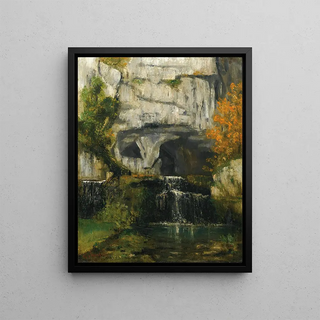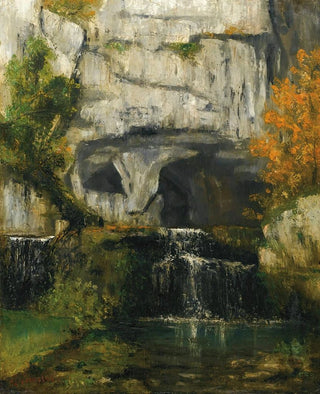Art print | La Source du Lison - Gustave Courbet


View from behind

Frame (optional)
At the heart of bucolic 19th-century landscapes, "The Source of the Lison" by Gustave Courbet stands as a symbol of natural beauty and the power of realistic art. This artwork, which captures the very essence of nature through a meticulous and vibrant representation, transports us to a world where the gaze is lost in shades of green and water reflections. The scene depicts a bubbling spring, surrounded by rocks and foliage, evoking a serene tranquility that invites contemplation. Courbet, with his undeniable talent, manages to immortalize a fleeting moment of nature, making this painting a true ode to the splendor of our environment.
Style and uniqueness of the work
"The Source of the Lison" is distinguished by its realistic approach, characteristic of Courbet's style. The artist does not merely reproduce a landscape; he captures its soul, texture, and light. The detailed leaves, the clarity of the water, and the robustness of the rocks testify to a keen eye and mastered technique. Each brushstroke seems to breathe life, while the colors, both vibrant and nuanced, create an immersive atmosphere. The composition, balanced and harmonious, guides the viewer's eye across the painting, inviting exploration of every corner of this wild nature. Courbet, by emphasizing faithful representation of nature, offers a reflection on the relationship between man and his environment, a theme close to his heart.
The artist and his influence
Gustave Courbet, an emblematic figure of realism, marked art history with his commitment to depict reality as it is, without embellishment or idealization. Born in 1819, he was part of a movement that opposed the academic conventions of his time. His work is not limited to simple representations of landscapes or scenes of daily life; it is also a social critique, a reflection on the human condition. Courbet inspired many artists across generations, paving the way for movements such as Impressionism. His boldness and artistic vision contributed to a reevaluation of art and its role in society.

Matte finish

View from behind

Frame (optional)
At the heart of bucolic 19th-century landscapes, "The Source of the Lison" by Gustave Courbet stands as a symbol of natural beauty and the power of realistic art. This artwork, which captures the very essence of nature through a meticulous and vibrant representation, transports us to a world where the gaze is lost in shades of green and water reflections. The scene depicts a bubbling spring, surrounded by rocks and foliage, evoking a serene tranquility that invites contemplation. Courbet, with his undeniable talent, manages to immortalize a fleeting moment of nature, making this painting a true ode to the splendor of our environment.
Style and uniqueness of the work
"The Source of the Lison" is distinguished by its realistic approach, characteristic of Courbet's style. The artist does not merely reproduce a landscape; he captures its soul, texture, and light. The detailed leaves, the clarity of the water, and the robustness of the rocks testify to a keen eye and mastered technique. Each brushstroke seems to breathe life, while the colors, both vibrant and nuanced, create an immersive atmosphere. The composition, balanced and harmonious, guides the viewer's eye across the painting, inviting exploration of every corner of this wild nature. Courbet, by emphasizing faithful representation of nature, offers a reflection on the relationship between man and his environment, a theme close to his heart.
The artist and his influence
Gustave Courbet, an emblematic figure of realism, marked art history with his commitment to depict reality as it is, without embellishment or idealization. Born in 1819, he was part of a movement that opposed the academic conventions of his time. His work is not limited to simple representations of landscapes or scenes of daily life; it is also a social critique, a reflection on the human condition. Courbet inspired many artists across generations, paving the way for movements such as Impressionism. His boldness and artistic vision contributed to a reevaluation of art and its role in society.






